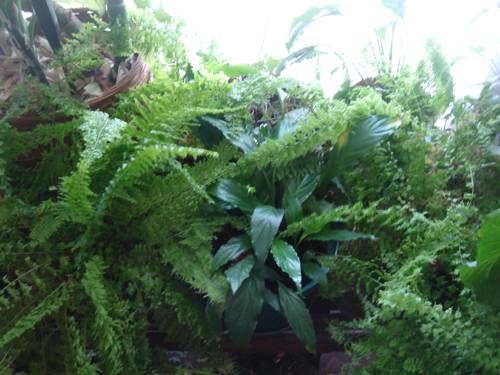
FAQ About Natural Light Adaptation in Indoor Ferns

What are the common indoor fern species that adapt well to low light conditions?
Some common indoor fern species that adapt well to low light conditions include the Boston Fern (Nephrolepis exaltata), the Maidenhair Fern (Adiantum spp.), and the Bird's Nest Fern (Asplenium nidus). These ferns have evolved to thrive under lower light levels, making them suitable for indoor environments with limited natural light.

How does natural light affect the growth of indoor ferns?
Natural light plays a crucial role in the photosynthesis process, which is essential for the growth and health of ferns. Most ferns prefer indirect light, as direct sunlight can scorch their delicate fronds. Properly managing light exposure helps prevent issues such as leaf burn and ensures vibrant, healthy foliage. Adjusting the position of the fern to optimize light exposure can significantly impact its growth and appearance.

Can ferns survive in completely dark rooms?
While ferns are quite adaptable and can tolerate lower light conditions, they cannot survive in completely dark rooms. Ferns require some light for photosynthesis to produce energy. If natural light is unavailable, supplementing with artificial grow lights can support their growth.

What is the ideal placement for ferns in a home to optimize natural light exposure?
The ideal placement for ferns in a home is near windows that offer bright, indirect light. East- or north-facing windows are often the best choices because they provide sufficient light without direct sun exposure, which can harm the ferns. Avoid placing ferns in direct sunlight or near heat sources to prevent drying out.

How can I tell if my fern is not getting enough light?
If a fern is not getting enough light, you might notice symptoms such as slow growth, pale or yellowing leaves, and weak or spindly fronds. Ensuring adequate indirect light exposure can help improve these conditions. Consider relocating the fern closer to a brighter area or using artificial lighting if natural light is insufficient.

Are there any ferns that prefer direct sunlight?
Most ferns prefer indirect light, but certain species, like the Rabbit's Foot Fern (Davallia fejeensis), can tolerate some direct sunlight, especially in cooler climates. However, they should still be protected from the intense afternoon sun to avoid leaf burn. Experiment with light exposure and monitor the fern's reaction to determine the best conditions.

What artificial lighting options can support indoor ferns when natural light is insufficient?
If natural light is insufficient, artificial lighting such as fluorescent or LED grow lights can support indoor ferns. These lights provide the necessary wavelengths for photosynthesis and should be placed a few feet above the plant to mimic natural light conditions. It is crucial to monitor both the light intensity and duration to mimic natural daylight cycles adequately.

How often should I rotate my indoor ferns for even light distribution?
Rotating indoor ferns every week or two ensures even light distribution across all sides of the plant. This prevents the fern from leaning towards the light source, promoting a balanced growth pattern. Regular rotation helps maintain a symmetrical shape and evenly distributed foliage.

What are some signs of too much light exposure in indoor ferns?
Signs of too much light exposure in indoor ferns include scorched or burnt fronds, crispy brown edges, and fading green color. If you notice these symptoms, move the fern to a location with more diffused light or provide filtered shading to protect it from direct sunlight.

How do seasonal changes in natural light affect the care of indoor ferns?
Seasonal changes in natural light can affect indoor ferns by altering the intensity and duration of sunlight available. During winter, when daylight hours are reduced, ferns may require closer placement to windows or supplemental lighting. In contrast, during summer, they may need protection from increased sunlight to prevent overheating and drying out.

Can indoor ferns acclimate to different light levels over time?
Yes, indoor ferns can acclimate to different light levels over time. Although they may initially experience stress when light conditions change, they often adapt with gradual exposure adjustments. Monitoring the fern's growth response and making incremental changes to its lighting environment can facilitate successful acclimation.

What types of windows are best suited for fern placement?
East- and north-facing windows are best suited for fern placement because they provide bright, indirect light throughout the day. These orientations prevent exposure to harsh midday sun, which can damage the leaves. West- and south-facing windows can be used with caution, ensuring that the ferns are protected from direct sunlight with curtains or blinds.

Should I use curtains or blinds to control the light for indoor ferns?
Using curtains or blinds can effectively control the light exposure on indoor ferns, especially when dealing with direct sunlight. Sheer curtains can diffuse harsh sunlight, converting it to a gentler light that ferns prefer. Adjusting blinds allows for easy modulation of light intensity, making them a versatile option for managing indoor lighting conditions for ferns.

How does the distance from a light source affect indoor ferns?
The distance from a light source significantly affects the amount of light that reaches indoor ferns. Closer proximity to a window or artificial light ensures more light exposure, while increased distance reduces it. Finding the right balance and adjusting the placement relative to the light source is important for optimizing their growth and health.

How can I enhance light conditions for ferns in a room with few windows?
Enhancing light conditions for ferns in a room with few windows can be achieved by using mirrors to reflect available light towards the plants, adding artificial grow lights to supplement natural light, or placing the ferns near lighter-colored walls that reflect light. These strategies help maximize the limited light and support healthy fern growth.

What role does humidity play alongside light in the adaptation of indoor ferns?
Humidity, alongside light, plays a crucial role in the adaptation and health of indoor ferns. Ferns thrive in environments with high humidity levels, which helps prevent their fronds from drying out. Combining appropriate light conditions with adequate humidity through misting, using a pebble tray, or a humidifier can optimize fern health and growth.

Can placing indoor ferns near LED lights damage them?
Placing indoor ferns near LED lights is generally safe and can be beneficial if the lights are specifically designed for plant growth. These lights should produce minimal heat and offer the correct spectrum of light for photosynthesis. Overexposure or placing the lights too close can stress the ferns, so it's important to follow manufacturer guidelines for optimal usage.

What are the consequences of inconsistent light exposure for indoor ferns?
Inconsistent light exposure can lead to erratic growth patterns, stress, and poor health in indoor ferns. Symptoms may include drooping fronds, uneven foliage coloration, and slowed growth. Maintaining a stable light environment with consistent exposure and intensity helps prevent these issues and ensures optimal fern development.

Are there specific care tips for ferns in office environments with artificial lighting?
When caring for ferns in office environments with artificial lighting, select grow lights that simulate natural daylight, monitor the light intensity to avoid stress, and ensure a consistent light schedule. Additionally, maintain adequate humidity levels, and place the ferns in areas free from heat sources like computers or vents to create a healthy indoor environment.

How can I transition a fern from outdoor to indoor conditions optimally?
To transition a fern from outdoor to indoor conditions, gradually acclimate it to the indoor light levels by initially placing it in a well-lit area away from direct sunlight. Gradually reduce light exposure over a period of two weeks to help the fern adjust. Monitor water and humidity needs during the transition to prevent stress and promote a smooth adaptation.
